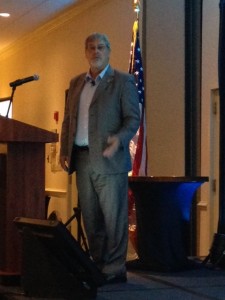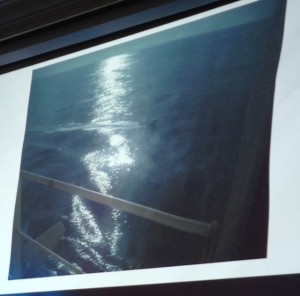By Leischen Stelter, editor In Public Safety
Attendees of the Mid-Atlantic Intel & Law Enforcement Training Seminar (INLETS) were treated to some Hollywood star power with a keynote address by Captain Richard Phillips, whose capture by Somali pirates was famously depicted in the movie, Captain Phillips, starring Tom Hanks.
Phillips shared his approach to leadership, confidence in the power of training, and unyielding attitude to never give up as the reasons he survived the 2009 hijacking of the MV Maersk Alabama.

Before the hijacking, Phillips spent four-and-a-half years sailing the dangerous waters off the coast of Africa well aware that his 17,000-ton ship was a high-target vessel. “Only a few months before my incident, a 1,000-foot ship was taken and held for $13 million in ransom,” he said.
Knowing this, he told crew members that it was a matter of when—not if—the ship would encounter pirates. “I believed that we could handle pirates if we had procedures and plans in place,” he said. “You have to hope for the best, but plan for the worst.”
When Training Saves Lives
As captain, Phillips was charged with managing a highly diverse group of crew who often hadn’t worked together. The first thing he noticed early in this voyage was that ship security seemed inadequate. Therefore, on the second day of the trip, he conducted an unannounced drill to see how his crew responded to a small boat aggressively approaching the ship. As expected, the crew response was less than desired.
“As a leader, you’re not interested in seeing anyone fail, but if they do fail, you want it to be in a training situation,” he said. After the drill, the crew spent a considerable amount of time talking about what could’ve been done better. “Any time you run a drill you find problems,” he said. “During this particular drill we found that some of our crew didn’t know the signal for a pirate attack. Also, the engine doors were not locked during the drill.”
The critiques and discussion following the drill also resulted in some new and creative solutions. “One new idea was to create a back-up safety room, which came into play just four days later,” Phillips said. “We talked through these ideas and solutions and everyone seemed to be on the same page, except for one crew member, we’ll call, Cliff [a reference to the character Cliff Clavin from the show Cheers],” he said.
The Attack
Just four days after the drill, the crew was forced to put their response plans into action. Captain Phillips recalled

being on the bridge at 6 a.m. discussing the day ahead and noting to a crew member that the seas were exceptionally flat that day and it was a “perfect piracy day.”
Not long after, a small skiff was spotted aggressively approaching the ship. Phillips sounded the alarm and ordered hoses to flow overboard in an attempt to sink the oncoming vessel. He could hear bullets pinging off the ship and saw the pirates hook a ladder over the railing and board the ship.
The pirates held Phillips and two crew members’ hostage on the bridge of the ship. “At first the pirates were happy, thinking they had just scored a big pay day from a rich American company,” said Phillips. But, as the hours passed and the pirates couldn’t locate the hiding crew, they started to get angry.
The pirates forced Phillips to call the crew to the bridge over the radio. “Thank God for our training because I didn’t use our code word over the radio,” he said. However, shortly after the radio announcement there was a knock on the door. “When I opened it, there was Cliff standing in the door. I thought, ‘Oh hi, Cliff. You’re dead.’”
The next 12 hours included a game of cat and mouse as the pirates attempted to locate the crew hiding in the back-up safety room. The crew had disengaged the engine, which left the bridge powerless to steer the ship so it drifted for 12 hours.
During this ordeal, Phillips recounted trying to regain some sense of control of the situation by talking with the pirates. “A successful leader always remains flexible and is constantly making little adjustments,” he said. He finally convinced them he could help them get off the ship (their boat and ladder had sunk upon boarding) by going with them on the life boat.
“Everything I learned in my training as a captain pointed to me being the last person off the ship, but I knew the best thing I could do for my crew was to get these pirates off the ship,” he said. “This wasn’t my surrender and I didn’t consider it an act of heroism—it was my action plan.”
Never Give Up

Phillips was finally rescued by the U.S. Navy, who he attributes as the real heroes of this ordeal.
Lessons Learned
Law enforcement can learn several lessons from Phillips’ experience. The first is to never doubt your ability to persevere. “You are much stronger than you know and you can take more than you think. It’s amazing the strength in all of us. Nothing is over until you quit and give in—it’s only final when we decide it is,” he said.
Another lesson is to never stop preparing, training, and improving as a team. Situations will always be different and there will always be new challenges to face.
“It’s better to face it with a well-trained crew than alone. A focused professional team working together can overcome any obstacle,” he said. “Looking back on the situation, everyone on my crew was glad that we took the time to run that drill.”
Regular and creative training helped ensure that such a terrifying situation had an ending good enough for Hollywood.
Comments are closed.